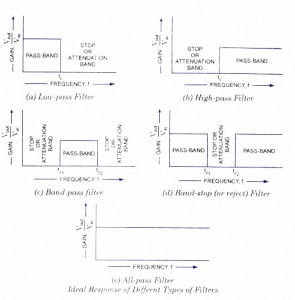Introduction to Filters
An electric filter is a network designed to attenuate certain frequencies but pass others without attenuation. A filter circuit, therefore, possesses at least one pass band — a band of frequencies in which the output is approximately equal to the input (that is, attenuation is zero) and an attenuation band in which output is zero (that is, attenuation is infinite). The frequencies that separate the different pass and attenuation bands are called the cut-off frequencies.
Filters may be of any type such as electrical, mechanical, pneumatic, hydraulic, acoustical etc. but the most commonly used filters are of the electrical type.
Electrical filters are used in practically all circuits which require separation of signals according to their frequencies. Applications include (but are certainly not limited to) noise rejection and signal separation in industrial and measurement circuits, feedback of phase and amplitude control in servo-loops, smoothing of digitally generated analog (D-A) signals, audio-signal shaping and sound enhancement, channel separation, and signal enhancement in communication circuits.
Classification of Filters
An electric filter .is usually a frequency-selective network that passes a specified band of frequencies and blocks or attenuates signals of frequencies outside this band. Filters may classified in a number of ways as follows :
- Analog or digital filters.
- Passive or active filters.
- Audio-frequency (AF) or radio-frequency (RF) filters.
Depending on the type of techniques used in the process of analog signals the filters may be analog or digital. Analog filters are designed to process analog signal using analog techniques, while digital filters process analog signals using digital techniques.
Depending on the type of elements used in their construction, filters may be passive or active. A passive filter is built with passive components such as resistors, capacitors and inductors. Active filters, on the other hand, make use of transistors or op-amps (providing voltage amplification, and signal isolation or buffering) in addition to resistors and capacitors. The type of elements used dictates the operating frequency range of the filter..
According to the operating frequency range, the filters may be classified as audio frequency (AF) or radio-frequency (RF) filters.
Filters may also be classified as
(i) low-pass,
(ii) high-pass
(iii) band-pass
(iv) band stop and
(v) all pass.
The filter circuit may be so designed that some frequencies are passed from the input to the output of the filter with very little attenuation while others are greatly attenuated.
Frequency Response Analysis of Different Types of Filters

Figure shows the frequency responses of the five types (mentioned above) of filters. These are ideal responses and cannot be achieved in,actual practice.
A filter that provides a constant output from dc upto a cut-off frequency fc and then passes no signal above that frequency is called an ideal low-pass filter. The ideal response of a low-pass filter is illustrated in fig. a. The voltage gain (the ratio of output voltage and input voltage, that is, Vout/Vin is constant over a frequency range from zero to cut-off frequency, fc. The output of any signal having a frequency exceeding fc will be attenuated i.e. there will be no output voltage for frequencies exceeding cut-off frequency fc. Hence output will be available faithfully from 0 to fc with constant gain, and is 0 from fc onward. The frequencies between 0 and f are, therefore, called the passband frequencies, while the range of frequencies, those beyond fc, that are attenuated includes the stopband frequencies. The bandwidth (BW) is, therefore, fc .
A filter that provides or passes signals above a cut-off frequency is a high-pass filter, as idealized in fig.b. The high-pass filter has a zero gain starting from zero to a frequency fc, called the cut-off frequency, and above this frequency, the gain is constant, as illustrated in fig. b. Thus signal of any frequency beyond fc is faithfully reproduced with a constant gain, and frequencies from 0 to fc will be attenuated.
When the filter circuit passes signals that are above one cut-off frequency and below a second cut-off frequency, it is called a band-pass filter, as idealized in fig.c. Thus a band-pass filter has a pass band between two cut-off frequencies fc2 and fc1 where fc2 > fcl and two stop-bands : 0 < f< fcl and f> fc2. The bandwidth of the band-pass filter is, therefore, equal to fc2 – fcl where fcl and fc2 are lower and higher cut-off frequencies respectively.
The band-stop or band-reject filter performs exactly opposite to the band-pass i.e. it has a bandstop between two cut-off frequencies fc2 and fcl and two passbands : 0 < f < fc1 and f> fc2. The ideal response of a band-stop filter is illustrated in fig. d. This is also called a band-elimination or notch filter.
The ideal response of an all-pass filter is shown in fig. e. This filter passes all frequencies equally well, i.e., output and input voltages are equal in amplitude for all frequencies. The important feature of this filter is that it provides predictable phase shift for frequencies of different input signals.
The filter discussed above has ideal characteristics and a sharp cut-off but unfortunately, ideal filter response is not practical because linear networks cannot produce the discontinuities. However, it is possible to obtain a practical response that approximates the ideal response by using special design techniques, as well as precision component values and high-speed op-amps.

10 Comments
can you give me or explain all above filter circuits ?
respected sir,
i requsted to 12V sub woofer filter circut for my car auido systam.
my car audio systam out put IC is LA 44440 & I Have 8 Oham 100W SUB WOOFER. SO i Requst you plase sent digram.
biju .
Here is the circuit you requested
https://www.circuitstoday.com/car-subwoofer-filter